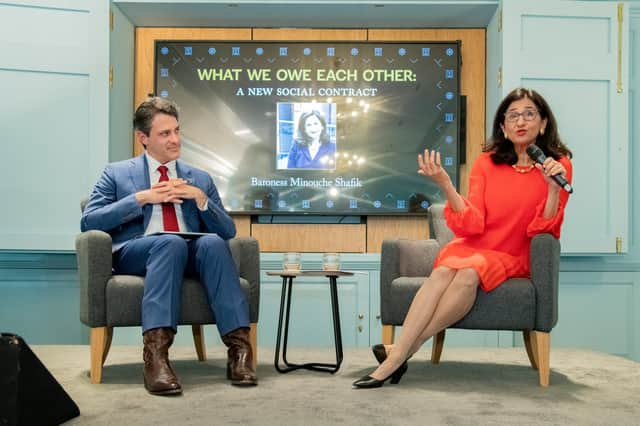Panmure House: Lecture held to celebrate 300th anniversary of Adam Smith's birth


Baroness Minouche Shafik, delivering the annual Adam Smith lecture at Panmure House in Edinburgh, where Smith lived for 12 years until his death in 1790, said his fame as the father of modern economics often overshadowed his second great work - which displayed a deep understanding of “fellow feeling”, or empathy.
She said it was “the culmination of a dream to give a lecture in the name of Adam Smith in his only surviving residence”, praising his enduring legacy of using “reason, empirical evidence and civic engagement to prevent conflict and advance human flourishing”. This legacy had to be defended in the face of mounting populism and tribalism, she argued.
In the lecture, the former Deputy Governor of the Bank of England outlined the thinking in her book What We Owe Each Other: A New Social Contract for a Better Society.
She said Smith’s Wealth of Nations was a work of genius and “one of the most important works in the history of the social sciences” - but was often reduced unfairly to a “narrow justification of self-interest”.
She added: “Smith was a moral philosopher long before he was an economist. ‘Fellow feeling’ (what we might now call empathy) was at the heart of The Theory of Moral Sentiments. The historic focus on Smith is too much on his self-interest legacy and nor enough on this ‘sympathy’
legacy.”
Baroness Shafik said that a failure to see the “interaction between self-interest and sympathy” was at the heart of many modern social and economic problems and there had been a “breakdown of the basic set of norms, rules, regulations and obligations which bind individuals,[businesses] and the state together - the social contract.”
At the heart of this was the fundamental question of what the state should provide individuals and what it should ask of them, she said - while differentiating her idea of a social contract from the narrower definition of the welfare state.
Currently, Shafik said, there was a failure to provide a minimum level of security for the worst off, while sluggish economic growth was embedding inequality. “Our social contract is broken so how can we organise ourselves differently to provide greater opportunity?” she asked.
At the heart of this broken contract, she suggested, was the fact that societies are often still organised on outdated 20th century norms, including women providing the vast majority of childcare, long-term relationships, ‘jobs for life’, limited years of life after retirement, and education focused almost entirely on the period from primary school to university.
Despite huge changes - including far more women in the labour market, the growing ‘informality’ of work and the transformative impact of technology - these norms were still too present in policy-making, she argued.
She put forward three guiding principles that she felt were fundamental to re-balancing this social contract:
● Minimum security for all;
● Maximum investment in opportunity and capability;
● Better risk-sharing
Shafik also highlighted specific policies that would have a positive impact on re-balancing the social contract, including a stronger focus on the first 1000 days of life (especially nutrition and mental stimulation), an endowment to support lifelong learning, and balancing the flexible benefits of the gig economy with guaranteed support for workers who lose their jobs.
She called for a greater understanding of the interdependence of different generations, and said investing heavily in the education of young people would enable them to be more productive, and give more back, over their longer working lives. This was linked to equality of opportunity, she added, saying: “In too many places, talent is wasted because opportunities are not provided to all.” More had to be done to ensure ‘Lost Einsteins’ didn’t slip through the net, she said.
In terms of risk-sharing, Shafik said: “Too many risks are being borne by individuals when it is more efficient to manage them collectively.”
When it came to raising more money to fund some of her ideas, Shafik said she favoured a better system of land and property tax, and a carbon tax. “Some people argue for a wealth tax but two-third of global wealth is in the form of property, so it [property] is a pretty good proxy [for wealth],” she argued. “And taxing carbon can accelerate the transition to a more sustainable economy.”
She said that while it was “tempting to involve the Robin Hood solution” of redistributing wealth, she was in favour of making systemic changes which focused on “pre-distribution”. She said changes like equal access to educational opportunity , creating endowments for lifelong learning and reducing dependency on the state would help with this shift.
“We owe each other more than the current social contract delivers,” she said. “We need to combine the invisible hand of the market with the visible hand of sympathy.”
This could create the “foundations for a society based on recognising interdependence and potential, and asking everyone to contribute as much as they can to the common good.”
She concluded: “This would marry the two points of Adam Smith’s legacy [articulated in The Wealth of Nations and The Theory of Moral Sentiments] in a way which he would have thoroughly approved.”
Baroness Shafik, currently Vice-Chancellor of the London School of Economics, moves to the United States in July to become the first female President of Columbia University in New York since its foundation in 1754.
- Please sign up to the Panmure House newsletter and visit its What’s On page here